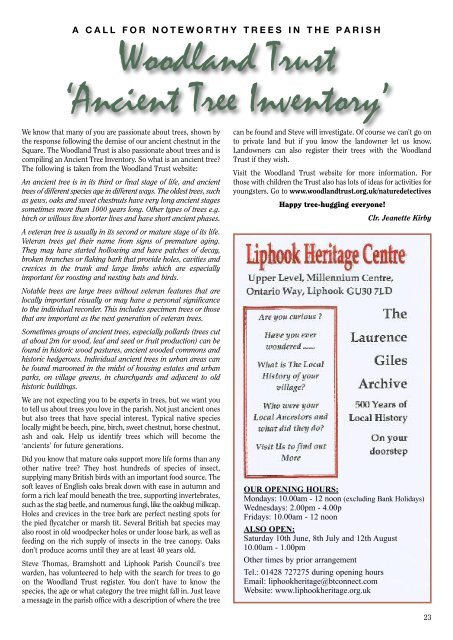Liphook Community Magazine Summer 2017
The Liphook Community Magazine exists to help maintain, encourage and initiate aspects of community life in which individuality, creativeness and mutual fellowship can flourish. It is produced and distributed by volunteers, free, to every household in the Parish of Bramshott and Liphook. It is financed by advertising and donations from individuals and organisations.
The Liphook Community Magazine exists to help maintain, encourage and initiate aspects of community life in which individuality, creativeness and mutual fellowship can flourish. It is produced and distributed by volunteers, free, to every household in the Parish of Bramshott and Liphook. It is financed by advertising and donations from individuals and organisations.
You also want an ePaper? Increase the reach of your titles
YUMPU automatically turns print PDFs into web optimized ePapers that Google loves.
A C A L L F O R N O T E W O R T H Y T R E E S I N T H E P A R I S H<br />
Woodland Trust<br />
‘Ancient Tree Inventory’<br />
We know that many of you are passionate about trees, shown by<br />
the response following the demise of our ancient chestnut in the<br />
Square. The Woodland Trust is also passionate about trees and is<br />
compiling an Ancient Tree Inventory. So what is an ancient tree?<br />
The following is taken from the Woodland Trust website:<br />
An ancient tree is in its third or final stage of life, and ancient<br />
trees of different species age in different ways. The oldest trees, such<br />
as yews, oaks and sweet chestnuts have very long ancient stages<br />
sometimes more than 1000 years long. Other types of trees e.g.<br />
birch or willows live shorter lives and have short ancient phases.<br />
A veteran tree is usually in its second or mature stage of its life.<br />
Veteran trees get their name from signs of premature aging.<br />
They may have started hollowing and have patches of decay,<br />
broken branches or flaking bark that provide holes, cavities and<br />
crevices in the trunk and large limbs which are especially<br />
important for roosting and nesting bats and birds.<br />
Notable trees are large trees without veteran features that are<br />
locally important visually or may have a personal significance<br />
to the individual recorder. This includes specimen trees or those<br />
that are important as the next generation of veteran trees.<br />
Sometimes groups of ancient trees, especially pollards (trees cut<br />
at about 2m for wood, leaf and seed or fruit production) can be<br />
found in historic wood pastures, ancient wooded commons and<br />
historic hedgerows. Individual ancient trees in urban areas can<br />
be found marooned in the midst of housing estates and urban<br />
parks, on village greens, in churchyards and adjacent to old<br />
historic buildings.<br />
We are not expecting you to be experts in trees, but we want you<br />
to tell us about trees you love in the parish. Not just ancient ones<br />
but also trees that have special interest. Typical native species<br />
locally might be beech, pine, birch, sweet chestnut, horse chestnut,<br />
ash and oak. Help us identify trees which will become the<br />
‘ancients’ for future generations.<br />
Did you know that mature oaks support more life forms than any<br />
other native tree? They host hundreds of species of insect,<br />
supplying many British birds with an important food source. The<br />
soft leaves of English oaks break down with ease in autumn and<br />
form a rich leaf mould beneath the tree, supporting invertebrates,<br />
such as the stag beetle, and numerous fungi, like the oakbug milkcap.<br />
Holes and crevices in the tree bark are perfect nesting spots for<br />
the pied flycatcher or marsh tit. Several British bat species may<br />
also roost in old woodpecker holes or under loose bark, as well as<br />
feeding on the rich supply of insects in the tree canopy. Oaks<br />
don’t produce acorns until they are at least 40 years old.<br />
Steve Thomas, Bramshott and <strong>Liphook</strong> Parish Council’s tree<br />
warden, has volunteered to help with the search for trees to go<br />
on the Woodland Trust register. You don’t have to know the<br />
species, the age or what category the tree might fall in. Just leave<br />
a message in the parish office with a description of where the tree<br />
can be found and Steve will investigate. Of course we can’t go on<br />
to private land but if you know the landowner let us know.<br />
Landowners can also register their trees with the Woodland<br />
Trust if they wish.<br />
Visit the Woodland Trust website for more information. For<br />
those with children the Trust also has lots of ideas for activities for<br />
youngsters. Go to www.woodlandtrust.org.uk/naturedetectives<br />
Happy tree-hugging everyone!<br />
Clr. Jeanette Kirby<br />
OUR OPENING HOURS:<br />
Mondays: 10.00am - 12 noon (excluding Bank Holidays)<br />
Wednesdays: 2.00pm - 4.00p<br />
Fridays: 10.00am - 12 noon<br />
ALSO OPEN:<br />
Saturday 10th June, 8th July and 12th August<br />
10.00am - 1.00pm<br />
Other times by prior arrangement<br />
Tel.: 01428 727275 during opening hours<br />
Email: liphookheritage@btconnect.com<br />
Website: www.liphookheritage.org.uk<br />
23

















